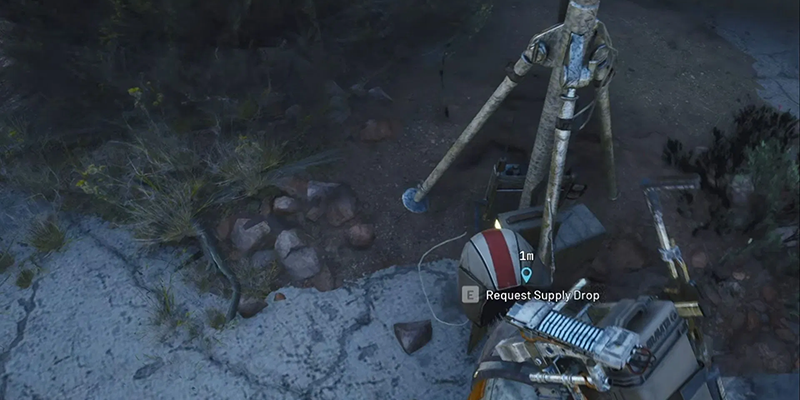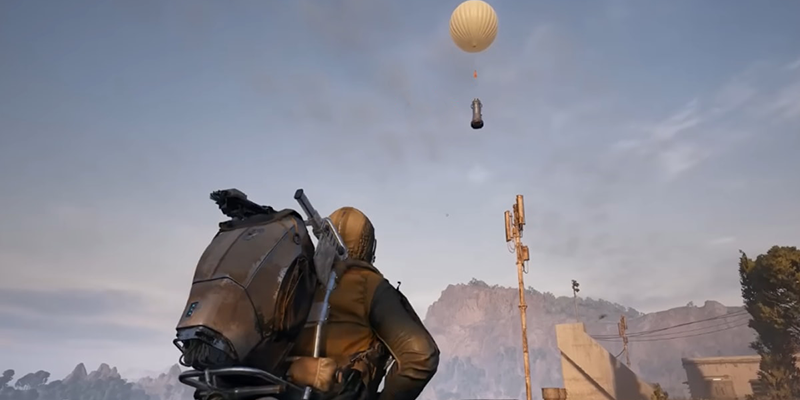Understanding Supply Drop Call Stations
Supply Drop Call Stations are emergency resupply points scattered across Arc Raiders maps. You'll recognize them as antenna installations with poles that have three downward-pointing prongs at the top and a flashing light. An interactive console sits at the base where you can request supplies.
These stations work best as restocking options when you're running low on ammunition or healing items during extended raids. You'll also need to find and use one if you're working on the A Better Use quest.

How the Supply Drop System Works
Requesting and collecting a supply drop creates both opportunities and risks. Here's how the process unfolds.
Initial Request Process
Find a Supply Call Station antenna structure and head to the console at its base. Interact with the console to request a supply drop. A flare launches into the sky immediately when you activate it.
Waiting Period and Risks
After you request the drop, you'll wait about 15 seconds before the supply pod arrives. During this time, the flare acts as a visible signal to all players in the lobby, broadcasting your exact location. This creates a vulnerability window where hostile raiders may head straight for you.
Collection Process
Once the pod arrives by balloon, watch the flare's trajectory to figure out where it's landing. The supplies arrive in a large tube container that looks similar to an ARC Probe. You'll need to breach this container to access what's inside.
Supply Contents
Supply drops contain basic restocking materials rather than rare equipment. Expect to find:
- Ammunition
- Grenades
- Crafting materials
- Basic healing supplies
Finding Call Stations on Your Map
Call Stations present a unique tracking challenge compared to other map elements. The quest giver for A Better Use tells you that these stations appear on the map, but this information needs clarification.
Map Visibility Mechanics
Call stations don't display icons on the full map view regardless of how far away you are. Instead, icons only appear on the mini-map when you move into close proximity to a station. This proximity requirement means you can't identify station locations from a distance using the main map interface.

Visual Identification Methods
The antennas themselves are thin structures that can be difficult to spot in the environment. They somewhat resemble umbrellas in their general shape. If you bring binoculars on your raids, you can scan distant areas to potentially identify these structures before approaching, though the proximity requirement for map icons stays the same.
Call Station Spawn Mechanics
Supply Call Stations operate under spawn rules that affect their availability.
Competition Factor
Other raiders may reach call stations before you do. If another player has already requested a drop and collected the supplies, the station will be unavailable for the rest of that raid instance.
Dam Battlegrounds Call Station Locations
The Dam Battlegrounds map contains multiple Supply Drop Call Station locations, with most concentrated in the central region.
Hydroponic Dome Complex Location
The center of the Hydroponic Dome Complex provides a consistently reliable call station spawn point. This location typically hosts ARC presence, which can actually work in your favor. The ARC enemies often deter other players from engaging in direct combat unless they're willing to risk confrontation with both ARCs and rival raiders. This ARC presence can let you approach quickly, activate the drop, and monitor the sky for arrival without as much player interference.
Primary Facility Area
Near the primary facility on Dam Battlegrounds, call stations have spawned with reliable frequency. Multiple successful drop requests have been completed at this location.
Central Region Concentration
Since most call stations cluster in the map's center, expect encounters with other raiders when accessing these stations. The central positioning creates natural convergence points for player movement.
Buried City Call Station Locations
The Buried City map features a more limited selection of Supply Drop Call Station locations compared to Dam Battlegrounds. The smaller overall map size directly corresponds to fewer available station spawn points.
Blue Gate Call Station Locations
The Blue Gate map contains its own set of call station locations, but you should exercise increased caution when using them. This map features higher than normal ARC presence throughout the region, creating additional danger when the flare announces your position during supply drop requests.
Spaceport Call Station Locations
The Spaceport map includes multiple Supply Drop Call Station locations that have been identified across the region.

Strategic Considerations for Supply Drops
When to Use Supply Drops
Supply drops serve best as emergency restocking options during raids when ammunition or healing items run out. Since the contents consist of basic supplies rather than rare equipment, avoid calling drops unless you genuinely need to restock. The risk of broadcasting your location to the entire lobby outweighs the benefit if you don't actually need the supplies.
Tactical Approach
Before requesting a drop, verify that no other raiders are tracking your movement. The 15-second waiting period after launching the flare creates vulnerability, so clear the immediate area of threats before activation.
Sky Monitoring
Keep your attention on the sky after the flare launches. The flare's trajectory indicates where the balloon will deliver the supply pod. Tracking this trajectory means you can move directly to the landing site for quick collection.
Interception Risk
Other players who spot the supply balloon can reach the pod and collect the contents if they arrive before you. The breach process takes time, so speed matters when collecting your requested supplies.
Quest Completion Priority
For players focused solely on completing the A Better Use quest or related assignments rather than actually needing supplies, target the Dam Battlegrounds locations near the primary facility or the Hydroponic Dome Complex center for the most consistent spawn rates.
Common Challenges and Solutions
Location Difficulty
Many players struggle initially with finding call stations due to the proximity-based map icon system and the thin antenna structures. The combination of needing close range for mini-map icons and the small visual profile makes initial discovery challenging. Using binoculars for distant scanning can help identify potential antenna locations before committing to an approach route.
Alert Radius
The flare alerts "probably all the raiders around you" according to field reports, creating danger during the waiting period. Some successful drop collections have occurred without any raiders responding, suggesting that response depends on current player positions and engagement status elsewhere on the map.
Spawn Inconsistency
Call stations don't always spawn in identical spots between raids. While certain locations show higher spawn frequency, no location guarantees a call station will be present. Plan alternative routes to check multiple potential spawn points if your primary target location proves empty.

